Enzyme Biosensor Based on 3D-Printed Flow-Through Reactor Modified with Thiacalixarene-Functionalized Oligo (Lactic Acids)
Abstract
1. Introduction
2. Materials and Methods
2.1. Reagents
2.2. Modification of Screen-Printed Carbon Electrode (SPCE)
2.3. Flow-Through Cell Manufacture
2.4. Enzyme Immobilization and Signal Measurement
2.5. Hydrolytic Degradation and Swelling of Oligo (Lactic Acids)
3. Results and Discussion
3.1. Design of 3D-Printed Flow-Through Cell
3.2. Swelling and Hydrolytic Degradation of Thiacalixarene-Functionalized Oligo (Lactic Acids) Used to Modify the Flow-Through Electrochemical Cell Reactor Chamber
3.3. Registration of Hydrogen Peroxide Using a Prussian Blue-Based Sensor
3.4. Biosensor System for Uric Acid Determination
4. Conclusions
Author Contributions
Funding
Institutional Review Board Statement
Informed Consent Statement
Data Availability Statement
Conflicts of Interest
References
- Ozcelikay, G.; Karadurmus, L.; Kaya, S.I.; Bakirhan, N.K.; Ozkan, S.A. A Review: New Trends in Electrode Systems for Sensitive Drug and Biomolecule Analysis. Crit. Rev. Anal. Chem. 2020, 50, 212–225. [Google Scholar] [CrossRef] [PubMed]
- Zhang, Y.V.; Wei, B.; Zhu, Y.; Zhang, Y.; Bluth, M.H. Liquid Chromatography–Tandem Mass Spectrometry: An Emerging Technology in the Toxicology Laboratory. Clin. Lab. Med. 2016, 36, 635–661. [Google Scholar] [CrossRef] [PubMed]
- Duan, W.; Gunes, M.; Baldi, A.; Gich, M.; Fernández-Sánchez, C. Compact Fluidic Electrochemical Sensor Platform for On-Line Monitoring of Chemical Oxygen Demand in Urban Wastewater. Chem. Eng. J. 2022, 449, 137837. [Google Scholar] [CrossRef]
- Macovei, D.-G.; Irimes, M.-B.; Hosu, O.; Cristea, C.; Tertis, M. Point-of-Care Electrochemical Testing of Biomarkers Involved in Inflammatory and Inflammatory-Associated Medical Conditions. Anal. Bioanal. Chem. 2023, 415, 1033–1063. [Google Scholar] [CrossRef]
- Baranwal, J.; Barse, B.; Gatto, G.; Broncova, G.; Kumar, A. Electrochemical Sensors and Their Applications: A Review. Chemosensors 2022, 10, 363. [Google Scholar] [CrossRef]
- Sahragard, A.; Varanusupakul, P.; Miró, M. Nanomaterial Decorated Electrodes in Flow-through Electrochemical Sensing of Environmental Pollutants: A Critical Review. Trends Environ. Anal. Chem. 2023, 39, e00208. [Google Scholar] [CrossRef]
- Mulchandani, A. Principles of Enzyme Biosensors. In Enzyme and Microbial Biosensors: Techniques and Protocols; Mulchandani, A., Rogers, K.R., Eds.; Humana Press: Totowa, NJ, USA, 1998; pp. 3–14. ISBN 978-1-59259-484-9. [Google Scholar]
- Cheng, J.; Wu, Y.; Zhu, L.; Lin, S.; Liu, Y.; Huang, K.; Xu, W. Uric Acid Biosensors Based on Molecular Recognition: Classifications, Advances, and Prospects. TrAC 2024, 179, 117887. [Google Scholar] [CrossRef]
- Chelmea, L.; Badea, M.; Scarneciu, I.; Moga, M.A.; Dima, L.; Restani, P.; Murdaca, C.; Ciurescu, D.; Gaman, L.E. New Trends in Uric Acid Electroanalysis. Chemosensors 2023, 11, 341. [Google Scholar] [CrossRef]
- Cancelliere, R.; Tinno, A.D.; Cataldo, A.; Bellucci, S.; Micheli, L. Powerful Electron-Transfer Screen-Printed Platforms as Biosensing Tools: The Case of Uric Acid Biosensor. Biosensors 2022, 12, 2. [Google Scholar] [CrossRef]
- Abellán-Llobregat, A.; González-Gaitán, C.; Vidal, L.; Canals, A.; Morallón, E. Portable Electrochemical Sensor Based on 4-Aminobenzoic Acid-Functionalized Herringbone Carbon Nanotubes for the Determination of Ascorbic Acid and Uric Acid in Human Fluids. Biosens. Bioelectron. 2018, 109, 123–131. [Google Scholar] [CrossRef]
- Ben Salem, C.; Slim, R.; Fathallah, N.; Hmouda, H. Drug-Induced Hyperuricaemia and Gout. Rheumatology 2017, 56, 679–688. [Google Scholar] [CrossRef] [PubMed]
- Borghi, C.; Agabiti-Rosei, E.; Johnson, R.J.; Kielstein, J.T.; Lurbe, E.; Mancia, G.; Redon, J.; Stack, A.G.; Tsioufis, K.P. Hyperuricaemia and Gout in Cardiovascular, Metabolic and Kidney Disease. Eur. J. Intern. Med. 2020, 80, 1–11. [Google Scholar] [CrossRef] [PubMed]
- Park, S.M.; Gi, M.Y.; Cha, J.A.; Sung, H.H.; Park, S.Y.; Park, C.H.; Yoon, H. The Relationship between Anemia and Hyperuricemia and Hypertension in Korean Adults: The Korea National Health and Nutrition Examination Survey 2016–2018. Curr. Med. Res. Opin. 2023, 39, 819–825. [Google Scholar] [CrossRef] [PubMed]
- Zhang, Y.; Liu, L.; Sun, X.; Li, H.; Wang, Y.; Zhou, M.; Hua, L.; Li, B.; Li, X. Updated Evidence of the Association Between Elevated Serum Uric Acid Level and Psoriasis. Front. Med. 2021, 8, 645550. [Google Scholar] [CrossRef]
- Rao, B.; Xie, D.; Deng, Y.; Ye, J.; Zeng, X.; Lin, A.; Chen, J.; Huang, D.; Xie, C.; Chen, C.; et al. Robust Positive Association between Serum Urate and the Risk of Chronic Obstructive Pulmonary Disease: Hospital-Based Cohort and Mendelian Randomisation Study. BMJ Open. Resp. Res. 2024, 11, e002203. [Google Scholar] [CrossRef]
- Navaee, A.; Salimi, A. Chapter 7—Enzyme-Based Electrochemical Biosensors. In Electrochemical Biosensors; Ensafi, A.A., Ed.; Elsevier: Amsterdam, The Netherlands, 2019; pp. 167–211. ISBN 978-0-12-816491-4. [Google Scholar]
- Ye, J.; Chu, T.; Chu, J.; Gao, B.; He, B. A Versatile Approach for Enzyme Immobilization Using Chemically Modified 3D-Printed Scaffolds. ACS Sustain. Chem. Eng. 2019, 7, 18048–18054. [Google Scholar] [CrossRef]
- Nguyen, H.H.; Lee, S.H.; Lee, U.J.; Fermin, C.D.; Kim, M. Immobilized Enzymes in Biosensor Applications. Materials 2019, 12, 121. [Google Scholar] [CrossRef]
- Meena, J.; Gupta, A.; Ahuja, R.; Singh, M.; Panda, A.K. Recent Advances in Nano-Engineered Approaches Used for Enzyme Immobilization with Enhanced Activity. J. Mol. Liq. 2021, 338, 116602. [Google Scholar] [CrossRef]
- Cheraghi, S.; Taher, M.A.; Karimi-Maleh, H.; Karimi, F.; Shabani-Nooshabadi, M.; Alizadeh, M.; Al-Othman, A.; Erk, N.; Yegya Raman, P.K.; Karaman, C. Novel Enzymatic Graphene Oxide Based Biosensor for the Detection of Glutathione in Biological Body Fluids. Chemosphere 2022, 287, 132187. [Google Scholar] [CrossRef]
- Lipińska, W.; Grochowska, K.; Siuzdak, K. Enzyme Immobilization on Gold Nanoparticles for Electrochemical Glucose Biosensors. Nanomaterials 2021, 11, 1156. [Google Scholar] [CrossRef]
- Bisswanger, H. Enzyme Assays. Perspect. Sci. 2014, 1, 41–55. [Google Scholar] [CrossRef]
- Bollella, P. Enzyme-Based Amperometric Biosensors: 60 Years Later … Quo Vadis? Anal. Chim. Acta 2022, 1234, 340517. [Google Scholar] [CrossRef] [PubMed]
- Schachinger, F.; Chang, H.; Scheiblbrandner, S.; Ludwig, R. Amperometric Biosensors Based on Direct Electron Transfer Enzymes. Molecules 2021, 26, 4525. [Google Scholar] [CrossRef] [PubMed]
- Matthews, C.J.; Andrews, E.S.V.; Patrick, W.M. Enzyme-Based Amperometric Biosensors for Malic Acid—A Review. Anal. Chim. Acta 2021, 1156, 338218. [Google Scholar] [CrossRef]
- Silva, A.L.; da Silva Salvador, G.M.; Castro, S.V.F.; Carvalho, N.M.F.; Munoz, R.A.A. A 3D Printer Guide for the Development and Application of Electrochemical Cells and Devices. Front. Chem. 2021, 9, 684256. [Google Scholar] [CrossRef]
- Stefano, J.S.; Kalinke, C.; da Rocha, R.G.; Rocha, D.P.; da Silva, V.A.O.P.; Bonacin, J.A.; Angnes, L.; Richter, E.M.; Janegitz, B.C.; Muñoz, R.A.A. Electrochemical (Bio)Sensors Enabled by Fused Deposition Modeling-Based 3D Printing: A Guide to Selecting Designs, Printing Parameters, and Post-Treatment Protocols. Anal. Chem. 2022, 94, 6417–6429. [Google Scholar] [CrossRef]
- Abdalla, A.; Patel, B.A. 3D Printed Electrochemical Sensors. Annu. Rev. Anal. Chem. 2021, 14, 47–63. [Google Scholar] [CrossRef]
- Stoikov, D.; Ivanov, A.; Shurpik, D.; Stoikov, I.; Evtugyn, G. Flow-Through Electrochemical Biosensor with a Replaceable Enzyme Reactor and Screen-Printed Electrode for the Determination of Uric Acid and Tyrosine. Anal. Lett. 2022, 55, 1281–1295. [Google Scholar] [CrossRef]
- Stoikov, D.; Ivanov, A.; Shafigullina, I.; Gavrikova, M.; Padnya, P.; Shiabiev, I.; Stoikov, I.; Evtugyn, G. Flow-Through Amperometric Biosensor System Based on Functionalized Aryl Derivative of Phenothiazine and PAMAM-Calix-Dendrimers for the Determination of Uric Acid. Biosensors 2024, 14, 120. [Google Scholar] [CrossRef]
- Stoikov, D.I.; Kappo, D.; Stoikov, D.I.; Shurpik, D.N.; Stoikov, I.I.; Evtugyn, G.A. Flow-through Chronoamperometric Sensor Based on Pillar [3]Arene [2]Quinone Derivative for Nitrophenol Determination and Its Application in a Model Effluent. Chim. Techno Acta 2025, 12, 12101. [Google Scholar] [CrossRef]
- Lim, L.-T.; Auras, R.; Rubino, M. Processing Technologies for Poly(Lactic Acid). Prog. Polym. Sci. 2008, 33, 820–852. [Google Scholar] [CrossRef]
- Van den Eynde, M.; Van Puyvelde, P. 3D Printing of Poly(Lactic Acid). In Industrial Applications of Poly(lactic acid); Di Lorenzo, M.L., Androsch, R., Eds.; Springer International Publishing: Cham, Switzerland, 2018; pp. 139–158. ISBN 978-3-319-75459-8. [Google Scholar]
- Joseph, T.M.; Kallingal, A.; Suresh, A.M.; Mahapatra, D.K.; Hasanin, M.S.; Haponiuk, J.; Thomas, S. 3D Printing of Polylactic Acid: Recent Advances and Opportunities. Int. J. Adv. Manuf. Technol. 2023, 125, 1015–1035. [Google Scholar] [CrossRef] [PubMed]
- Taib, N.-A.A.B.; Rahman, M.R.; Huda, D.; Kuok, K.K.; Hamdan, S.; Bakri, M.K.B.; Julaihi, M.R.M.B.; Khan, A. A Review on Poly Lactic Acid (PLA) as a Biodegradable Polymer. Polym. Bull. 2023, 80, 1179–1213. [Google Scholar] [CrossRef]
- da Silva, D.; Kaduri, M.; Poley, M.; Adir, O.; Krinsky, N.; Shainsky-Roitman, J.; Schroeder, A. Biocompatibility, Biodegradation and Excretion of Polylactic Acid (PLA) in Medical Implants and Theranostic Systems. Chem. Eng. J. 2018, 340, 9–14. [Google Scholar] [CrossRef]
- Ivanov, A.; Stoikov, D.; Shafigullina, I.; Shurpik, D.; Stoikov, I.; Evtugyn, G. Flow-Through Acetylcholinesterase Sensor with Replaceable Enzyme Reactor. Biosensors 2022, 12, 676. [Google Scholar] [CrossRef] [PubMed]
- Nontipichet, N.; Khumngern, S.; Choosang, J.; Thavarungkul, P.; Kanatharana, P.; Numnuam, A. An Enzymatic Histamine Biosensor Based on a Screen-Printed Carbon Electrode Modified with a Chitosan–Gold Nanoparticles Composite Cryogel on Prussian Blue-Coated Multi-Walled Carbon Nanotubes. Food Chem. 2021, 364, 130396. [Google Scholar] [CrossRef] [PubMed]
- Ramanavicius, S.; Ramanavicius, A. Charge Transfer and Biocompatibility Aspects in Conducting Polymer-Based Enzymatic Biosensors and Biofuel Cells. Nanomaterials 2021, 11, 371. [Google Scholar] [CrossRef]
- Kaya, A.; Onac, C.; Alpoguz, H.; Yilmaz, A.; Atar, N. Removal of Cr(VI) through Calixarene Based Polymer Inclusion Membrane from Chrome Plating Bath Water. Chem. Eng. J. 2016, 283, 141–149. [Google Scholar] [CrossRef]
- Nostrum, C.; Veldhuis, T.; Bos, G.; Hennink, W. Hydrolytic Degradation of Oligo (Lactic Acid): A Kinetic and Mechanistic Study. Polymer 2004, 45, 6779–6787. [Google Scholar] [CrossRef]
- George, K.; Chirila, T.; Wentrup-Byrne, E. Effects of Crosslink Density on Hydrolytic Degradation of Poly(L-Lactide)-Based Networks. Polym. Degrad. Stab. 2012, 97, 964–971. [Google Scholar] [CrossRef]
- Porfireva, A.; Gorbatchuk, V.; Evtugyn, V.; Stoikov, I.; Evtugyn, G. Glassy Carbon Electrode Modified with Silver Nanodendrites Implemented in Polylactide-Thiacalix[4]arene Copolymer for the Electrochemical Determination of Tryptophan. Electroanalysis 2017, 30, 641–649. [Google Scholar] [CrossRef]
- Xie, Y.; Liu, T.; Chu, Z.; Jin, W. Recent Advances in Electrochemical Enzymatic Biosensors Based on Regular Nanostructured Materials. J. Electroanal. Chem. 2021, 893, 115328. [Google Scholar] [CrossRef]
- Karimi, A.; Othman, A.; Andreescu, S. Portable Enzyme-Paper Biosensors Based on Redox-Active CeO2 Nanoparticles. In Methods in Enzymology; Kumar, C.V., Ed.; Rational Design of Enzyme-Nanomaterials; Academic Press: Cambridge, MA, USA, 2016; Volume 571, pp. 177–195. [Google Scholar]
- Medvedeva, A.S.; Dyakova, E.I.; Kuznetsova, L.S.; Mironov, V.G.; Gurkin, G.K.; Rogova, T.V.; Kharkova, A.S.; Melnikov, P.V.; Naumova, A.O.; Butusov, D.N.; et al. A Two-Mediator System Based on a Nanocomposite of Redox-Active Polymer Poly(Thionine) and SWCNT as an Effective Electron Carrier for Eukaryotic Microorganisms in Biosensor Analyzers. Polymers 2023, 15, 3335. [Google Scholar] [CrossRef] [PubMed]
- Estrada-Osorio, D.V.; Escalona-Villalpando, R.A.; Gutiérrez, A.; Arriaga, L.G.; Ledesma-García, J. Poly-L-Lysine-Modified with Ferrocene to Obtain a Redox Polymer for Mediated Glucose Biosensor Application. Bioelectrochemistry 2022, 146, 108147. [Google Scholar] [CrossRef]
- Fernández, L.; Alvarez-Paguay, J.; González, G.; Uribe, R.; Bolaños-Mendez, D.; Piñeiros, J.L.; Celi, L.; Espinoza-Montero, P.J. Electrochemical Sensor for Hydrogen Peroxide Based on Prussian Blue Electrochemically Deposited at the TiO2-ZrO2–Doped Carbon Nanotube Glassy Carbon-Modified Electrode. Front. Chem. 2022, 10, 884050. [Google Scholar] [CrossRef]
- Mohan Arjun, A.; Shabana, N.; Ankitha, M.; Abdul Rasheed, P. Electrochemical Deposition of Prussian Blue on Nb2CTx MXene Modified Carbon Cloth for the Non-Enzymatic Electrochemical Detection of Hydrogen Peroxide. Microchem. J. 2023, 185, 108301. [Google Scholar] [CrossRef]
- Suprun, E.V.; Karpova, E.V.; Radko, S.P.; Karyakin, A.A. Advanced Electrochemical Detection of Amino Acids and Proteins through Flow Injection Analysis and Catalytic Oxidation on Prussian Blue. Electrochim. Acta 2020, 331, 135289. [Google Scholar] [CrossRef]
- Shan, C.; Yang, H.; Han, D.; Zhang, Q.; Ivaska, A.; Niu, L. Graphene/AuNPs/Chitosan Nanocomposites Film for Glucose Biosensing. Biosens. Bioelectron. 2010, 25, 1070–1074. [Google Scholar] [CrossRef]
- Karyakin, A.A. Advances of Prussian Blue and Its Analogues in (Bio)Sensors. Curr. Opin. Electrochem. 2017, 5, 92–98. [Google Scholar] [CrossRef]
- Stoikov, D.; Shafigullina, I.; Shurpik, D.; Stoikov, I.; Evtugyn, G. A Flow-Through Biosensor System Based on Pillar [3]Arene [2]Quinone and Ferrocene for Determination of Hydrogen Peroxide and Uric Acid. Chemosensors 2024, 12, 98. [Google Scholar] [CrossRef]
- Gorbachuk, V.; Mostovaya, O.; Evtugyn, V.; Osin, Y.; Rizvanov, I.; Gerasimov, A.; Stoikov, I. Modification of Oligolactic Acid with Tetracarboxylic P-Tert-Butylthiacalix[4]Arene Derivatives: Effect of Macrocyclic Fragment Configuration on Aggregation and Thermal Properties of Copolyesters. Macroheterocycles 2017, 10, 174–181. [Google Scholar] [CrossRef][Green Version]
- Mostovaya, O.A.; Gorbachuk, V.V.; Bazanova, O.B.; Gerasimov, A.V.; Evtugyn, V.G.; Osin, Y.N.; Myakushev, V.D.; Rizvanov, I.K.; Stoikov, I.I. Thiacalixarene “Knot” Effect on Protein Binding by Oligolactic Acid Particles. Mater. Chem. Front. 2019, 3, 292–300. [Google Scholar] [CrossRef]
- Parham, H.; Zargar, B. Determination of Isosorbide Dinitrate in Arterial Plasma, Synthetic Serum and Pharmaceutical Formulations by Linear Sweep Voltammetry on a Gold Electrode. Talanta 2001, 55, 255–262. [Google Scholar] [CrossRef] [PubMed]
- Łysik, D.; Mystkowska, J.; Markiewicz, G.; Deptuła, P.; Bucki, R. The Influence of Mucin-Based Artificial Saliva on Properties of Polycaprolactone and Polylactide. Polymers 2019, 11, 1880. [Google Scholar] [CrossRef]
- Proikakis, C.S.; Mamouzelos, N.J.; Tarantili, P.A.; Andreopoulos, A.G. Swelling and Hydrolytic Degradation of Poly(d,l-Lactic Acid) in Aqueous Solutions. Polym. Degrad. Stab. 2006, 91, 614–619. [Google Scholar] [CrossRef]
- Bode, C.; Kranz, H.; Fivez, A.; Siepmann, F.; Siepmann, J. Often Neglected: PLGA/PLA Swelling Orchestrates Drug Release: HME Implants. J. Control. Release 2019, 306, 97–107. [Google Scholar] [CrossRef]
- Vayshbeyn, L.I.; Mastalygina, E.E.; Olkhov, A.A.; Podzorova, M.V. Poly(Lactic Acid)-Based Blends: A Comprehensive Review. Appl. Sci. 2023, 13, 5148. [Google Scholar] [CrossRef]
- Hamad, K.; Kaseem, M.; Yang, H.W.; Deri, F.; Ko, Y.G. Properties and Medical Applications of Polylactic Acid: A Review. Express Polym. Lett. 2015, 9, 435–455. [Google Scholar] [CrossRef]
- Gasparini, G.; Holdich, R.G.; Kosvintsev, S.R. PLGA Particle Production for Water-Soluble Drug Encapsulation: Degradation and Release Behaviour. Colloids Surf. B Biointerfaces 2010, 75, 557–564. [Google Scholar] [CrossRef]
- Padnya, P.L.; Andreyko, E.A.; Gorbatova, P.A.; Parfenov, V.V.; Rizvanov, I.K.; Stoikov, I.I. Towards Macrocyclic Ionic Liquids: Novel Ammonium Salts Based on Tetrasubstituted p-Tert-Butylthiacalix[4]Arenes. RSC Adv. 2017, 7, 1671–1686. [Google Scholar] [CrossRef]
- Pravda, J. Hydrogen Peroxide and Disease: Towards a Unified System of Pathogenesis and Therapeutics. Mol. Med. 2020, 26, 41. [Google Scholar] [CrossRef] [PubMed]
- Zhu, L.; Kreth, J. The Role of Hydrogen Peroxide in Environmental Adaptation of Oral Microbial Communities. Oxid. Med. Cell. Longev. 2012, 717843. [Google Scholar] [CrossRef] [PubMed]
- Xing, L.; Zhang, W.; Fu, L.; Lorenzo, J.M.; Hao, Y. Fabrication and Application of Electrochemical Sensor for Analyzing Hydrogen Peroxide in Food System and Biological Samples. Food Chem. 2022, 385, 132555. [Google Scholar] [CrossRef] [PubMed]
- Smirnoff, N.; Arnaud, D. Hydrogen Peroxide Metabolism and Functions in Plants. New Phytol. 2019, 221, 1197–1214. [Google Scholar] [CrossRef]
- Zhang, Y.; Cao, Q.; Zhu, F.; Xu, H.; Zhang, Y.; Xu, W.; Liao, X. An Amperometric Hydrogen Peroxide Sensor Based on Reduced Graphene Oxide/Carbon Nanotubes/Pt NPs Modified Glassy Carbon Electrode. Int. J. Electrochem. Sci. 2020, 15, 8771–8785. [Google Scholar] [CrossRef]
- Karyakin, A.A.; Gitelmacher, O.V.; Karyakina, E.E. A High-Sensitive Glucose Amperometric Biosensor Based on Prussian Blue Modified Electrodes. Anal. Lett. 1994, 27, 2861–2869. [Google Scholar] [CrossRef]
- Karyakin, A.A. Prussian blue and its analogues: Electrochemistry and analytical applications. Electroanalysis 2001, 13, 813–819. [Google Scholar] [CrossRef]
- Darabi, R.; Karimi-Maleh, H.; Akın, M.; Arıkan, K.; Zhang, Z.; Bayat, R.; Bekmezci, M.; Sen, F. Simultaneous Determination of Ascorbic Acid, Dopamine, and Uric Acid with a Highly Selective and Sensitive Reduced Graphene Oxide/Polypyrrole-Platinum Nanocomposite Modified Electrochemical Sensor. Electrochim. Acta 2023, 457, 142402. [Google Scholar] [CrossRef]
- Shanmugam, R.; Aniruthan, S.; Yamunadevi, V.; Nellaiappan, S.; Amali, A.J.; Suresh, D. Co-N/Zn@NPC Derived from Bimetallic Zeolitic Imidazolate Frameworks: A Dual Mode Simultaneous Electrochemical Sensor for Uric Acid and Ascorbic Acid. Surf. Interfaces 2023, 40, 103103. [Google Scholar] [CrossRef]
- Muhammad, F.; Dik, G.; Kolak, S.; Gedik, K.K.; Bakar, B.; Ulu, A.; Ateş, B. Design of Highly Selective, and Sensitive Screen-Printed Electrochemical Sensor for Detection of Uric Acid with Uricase Immobilized Polycaprolactone/Polyethylene Imine Electrospun Nanofiber. Electrochim. Acta 2023, 439, 141675. [Google Scholar] [CrossRef]
- Nong, J.; Zhang, N.; Wen, A.; Hu, C. Anti-Biofouling Laser-Scribed Graphene Electrochemical Sensor for Reliable Detection of Uric Acid in Human Saliva. J. Electroanal. Chem. 2024, 952, 117982. [Google Scholar] [CrossRef]

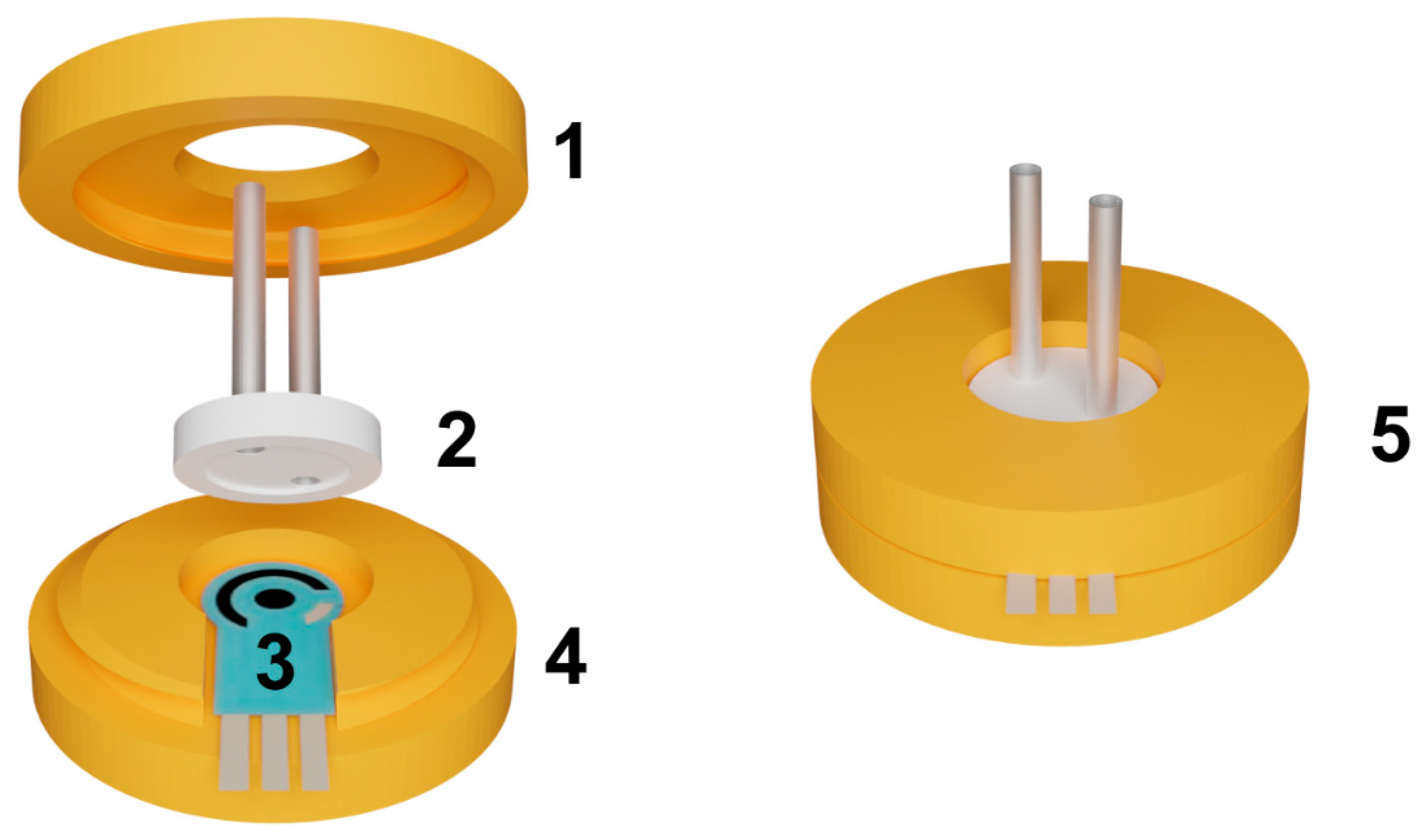

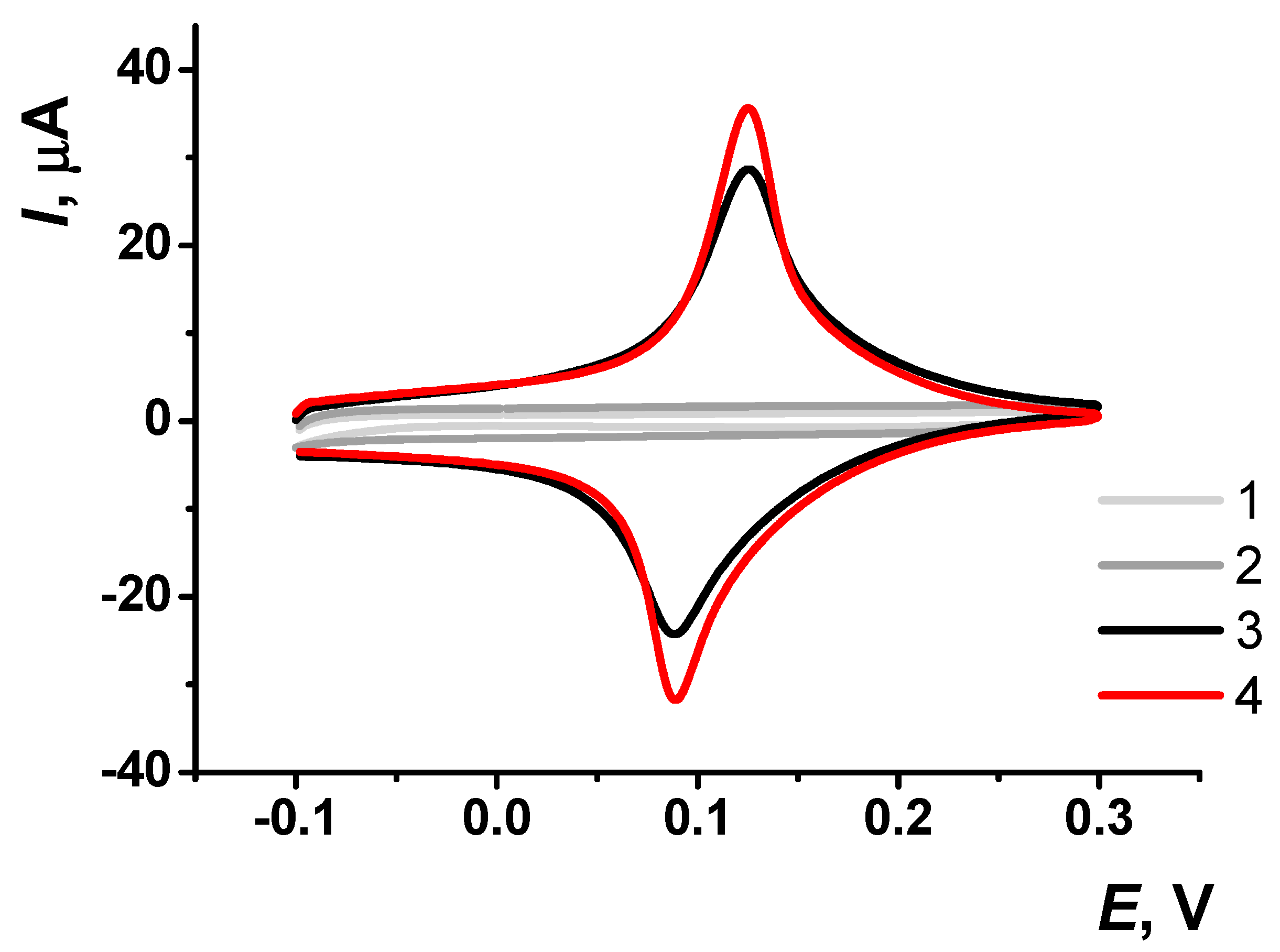

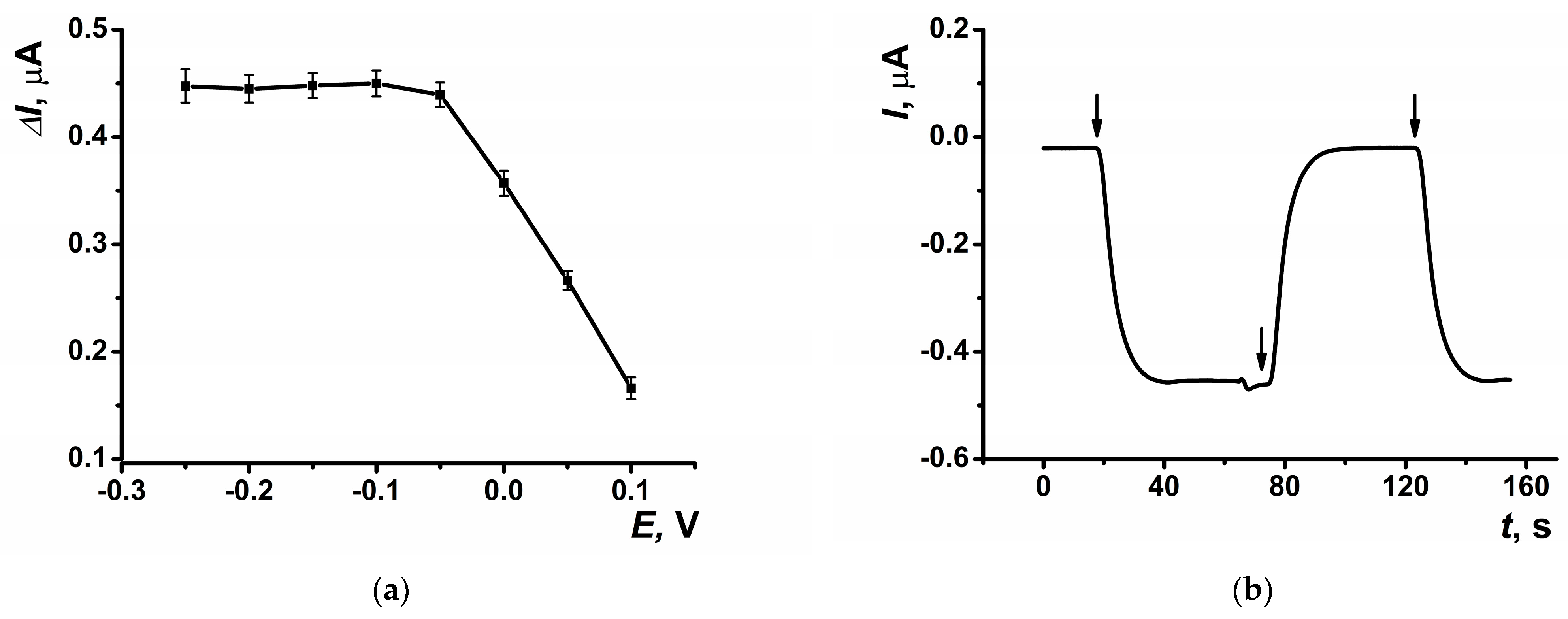
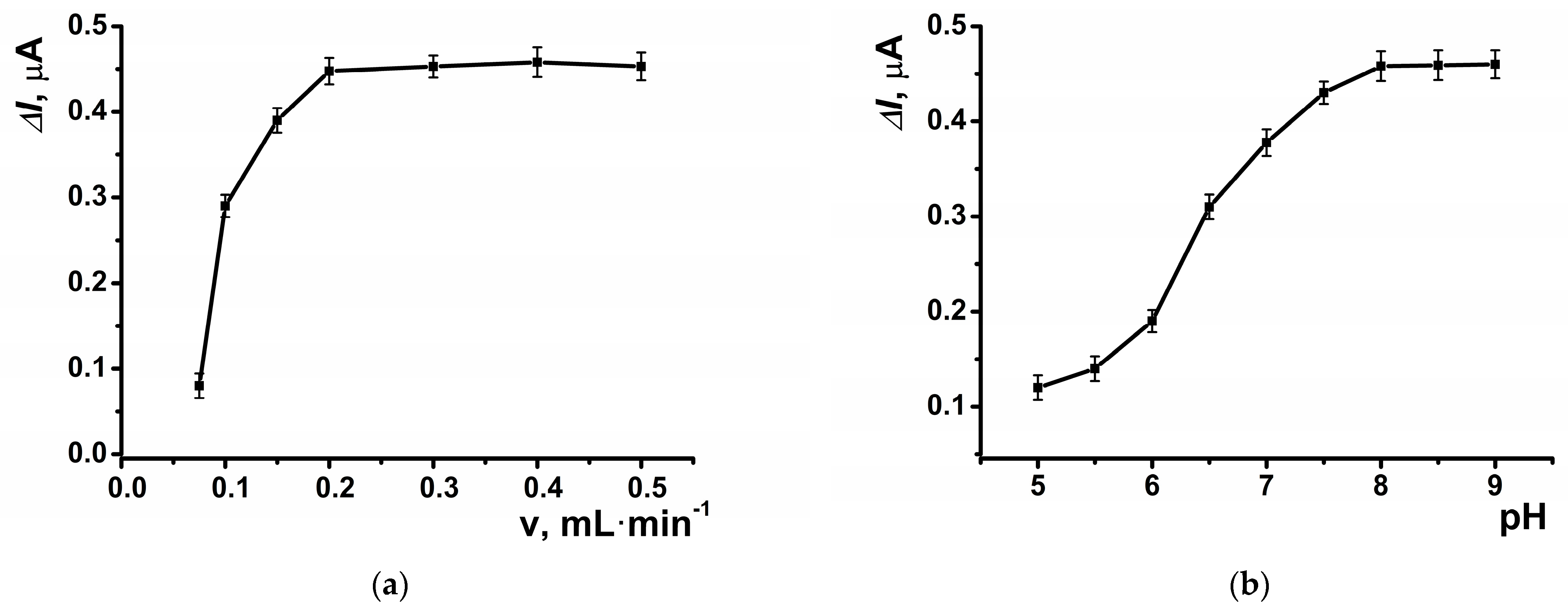

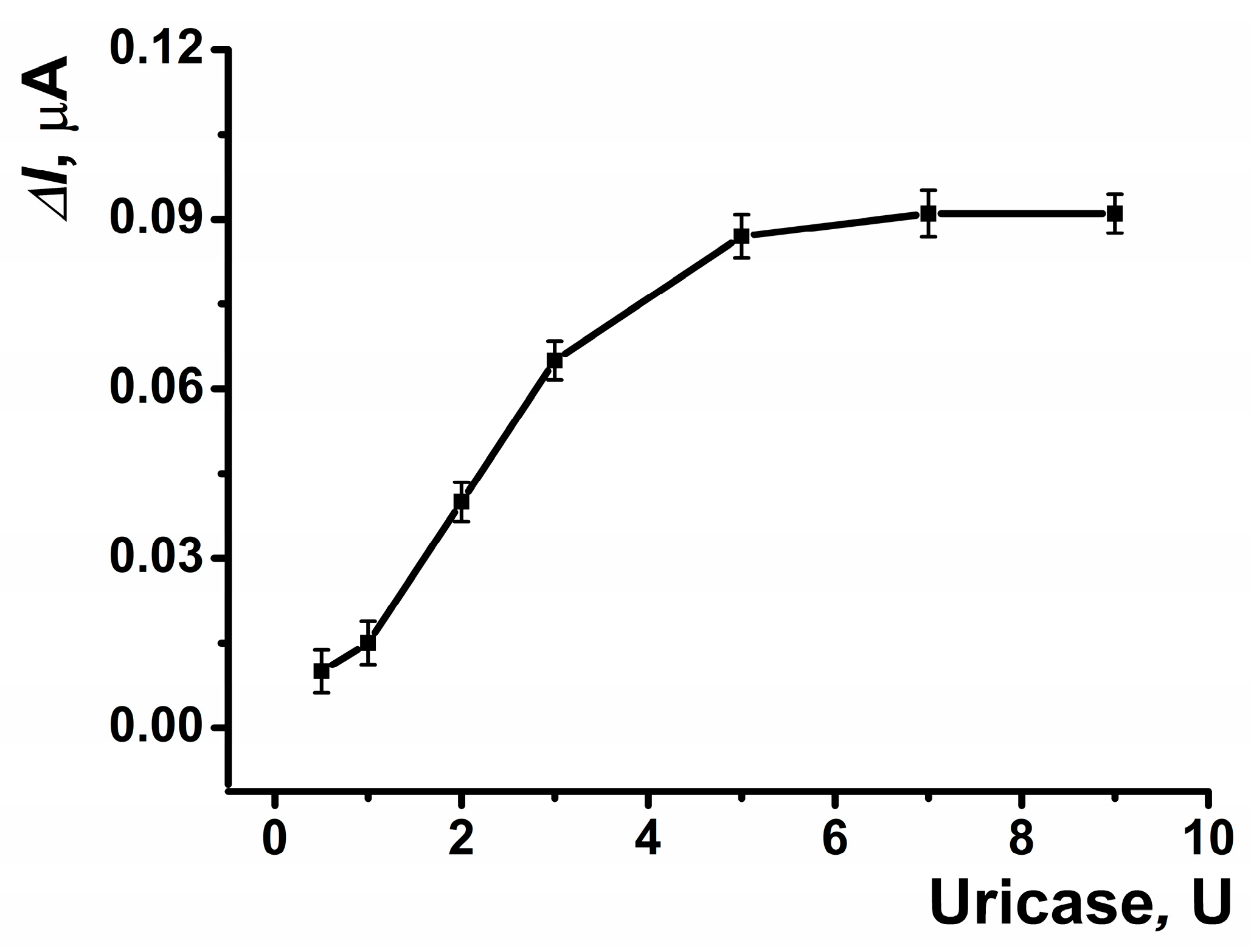
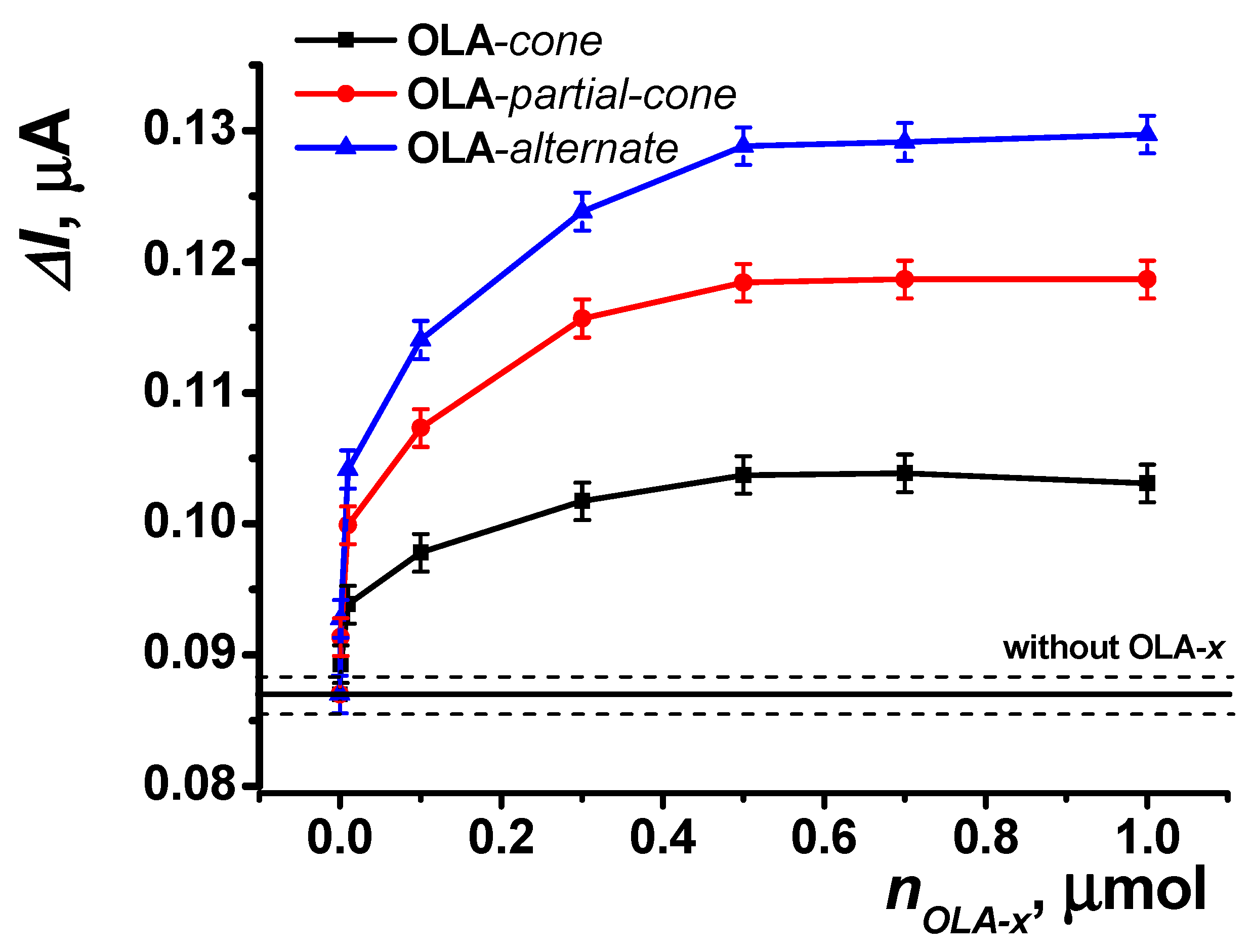
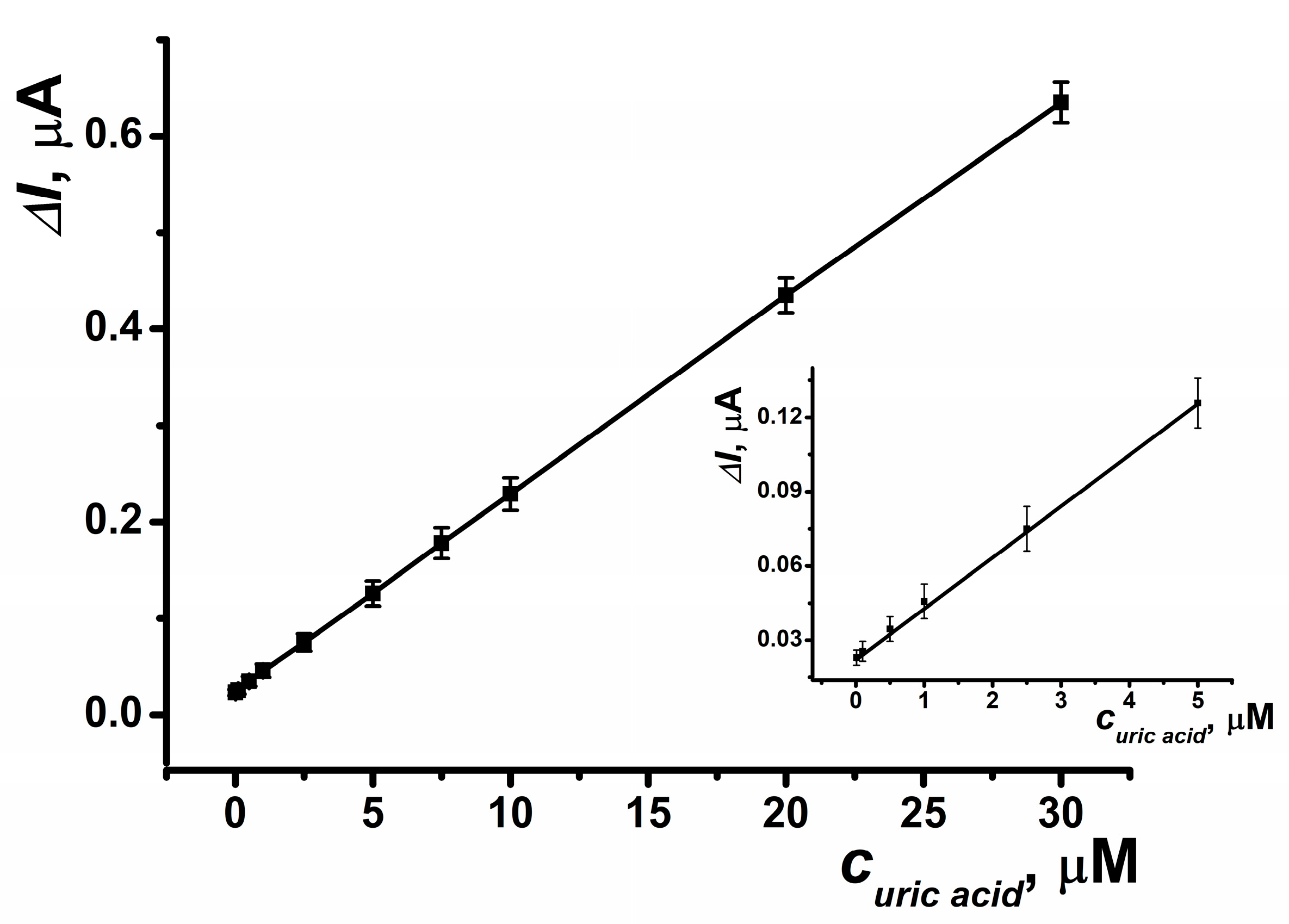
| Sample | pH 4.0 24 h | pH 6.9 24/168 h | pH 9.2 4 h | |||
|---|---|---|---|---|---|---|
| Degree of Swelling (%) | Weight Loss (%) | Degree of Swelling (%) | Weight Loss (%) | Degree of Swelling (%) | Weight Loss (%) | |
| OLA | 25 | 13 | 20/– * | 3/– * | 75 | 26 |
| OLA-cone | 17 | 10 | 15/– * | <0.5/– * | 35 | 8 |
| OLA-paco | 16 | 9 | 12/292 | <0.5/30 | 20 | 9 |
| OLA-alt | 6 | 4 | <0.5/73 | <0.5/21 | 5 | 4 |
| Electrode/Modifier | Detection Mode | Concentration Range, M | LOD, M | Ref. |
|---|---|---|---|---|
| Glassy carbon electrode, reduced graphene oxide/polypyrrole-platinum nanocomposite | Differential pulse voltammetry | 1 × 10−4–3.5 × 10−4 | 1.6 × 10−7 | [72] |
| Glassy carbon electrode, Co-N/Zn/nanoporous carbon, zeolite-like imidazolate framework | Differential pulse voltammetry | 1 × 10−7–1.47 × 10−5 | 1 × 10−7 | [73] |
| SPCE, polycaprolactone, polyethylene imine, uricase, quantum dots | Differential pulse voltammetry | 5 × 10−6–5.2 × 10−5 | 3.96 × 10−8 | [74] |
| Laser-induced graphene electrode, bovine serum albumin, TWEEN-20 | Differential pulse voltammetry | 2 × 10−5–1 × 10−3 | 2.1 × 10−6 | [75] |
| Uricase on reactor, PLA modified by p-tert-butylthiacalix[4]arene in 1,3-alternate conformation, SPCE, CB, PB | Differential pulse voltammetry | 1 × 10−8–3 × 10−5 | 7 × 10−9 | This work |
| Measurement Medium | Uric Acid, μM | Sr | Recovery, % | |
|---|---|---|---|---|
| Spiked | Found | |||
| Undiluted artificial urine | 10 | 12.1 ± 0.2 | 0.02 | 121 |
| 3 times diluted artificial urine | 10.7 ± 0.1 | 0.01 | 107 | |
| 10 times diluted artificial urine | 10.1 ± 0.1 | 0.01 | 101 | |
| Undiluted synthetic blood plasma | 10 | 13.4 ± 0.2 | 0.02 | 134 |
| 10 times diluted synthetic blood plasma | 11.2 ± 0.2 | 0.02 | 112 | |
| 100 times diluted synthetic blood plasma | 10.1 ± 0.1 | 0.01 | 102 | |
Disclaimer/Publisher’s Note: The statements, opinions and data contained in all publications are solely those of the individual author(s) and contributor(s) and not of MDPI and/or the editor(s). MDPI and/or the editor(s) disclaim responsibility for any injury to people or property resulting from any ideas, methods, instructions or products referred to in the content. |
© 2025 by the authors. Licensee MDPI, Basel, Switzerland. This article is an open access article distributed under the terms and conditions of the Creative Commons Attribution (CC BY) license (https://creativecommons.org/licenses/by/4.0/).
Share and Cite
Stoikov, D.; Kappo, D.; Ivanov, A.; Gorbachuk, V.; Mostovaya, O.; Padnya, P.; Stoikov, I.; Evtugyn, G. Enzyme Biosensor Based on 3D-Printed Flow-Through Reactor Modified with Thiacalixarene-Functionalized Oligo (Lactic Acids). Biosensors 2025, 15, 77. https://doi.org/10.3390/bios15020077
Stoikov D, Kappo D, Ivanov A, Gorbachuk V, Mostovaya O, Padnya P, Stoikov I, Evtugyn G. Enzyme Biosensor Based on 3D-Printed Flow-Through Reactor Modified with Thiacalixarene-Functionalized Oligo (Lactic Acids). Biosensors. 2025; 15(2):77. https://doi.org/10.3390/bios15020077
Chicago/Turabian StyleStoikov, Dmitry, Dominika Kappo, Alexey Ivanov, Vladimir Gorbachuk, Olga Mostovaya, Pavel Padnya, Ivan Stoikov, and Gennady Evtugyn. 2025. "Enzyme Biosensor Based on 3D-Printed Flow-Through Reactor Modified with Thiacalixarene-Functionalized Oligo (Lactic Acids)" Biosensors 15, no. 2: 77. https://doi.org/10.3390/bios15020077
APA StyleStoikov, D., Kappo, D., Ivanov, A., Gorbachuk, V., Mostovaya, O., Padnya, P., Stoikov, I., & Evtugyn, G. (2025). Enzyme Biosensor Based on 3D-Printed Flow-Through Reactor Modified with Thiacalixarene-Functionalized Oligo (Lactic Acids). Biosensors, 15(2), 77. https://doi.org/10.3390/bios15020077








